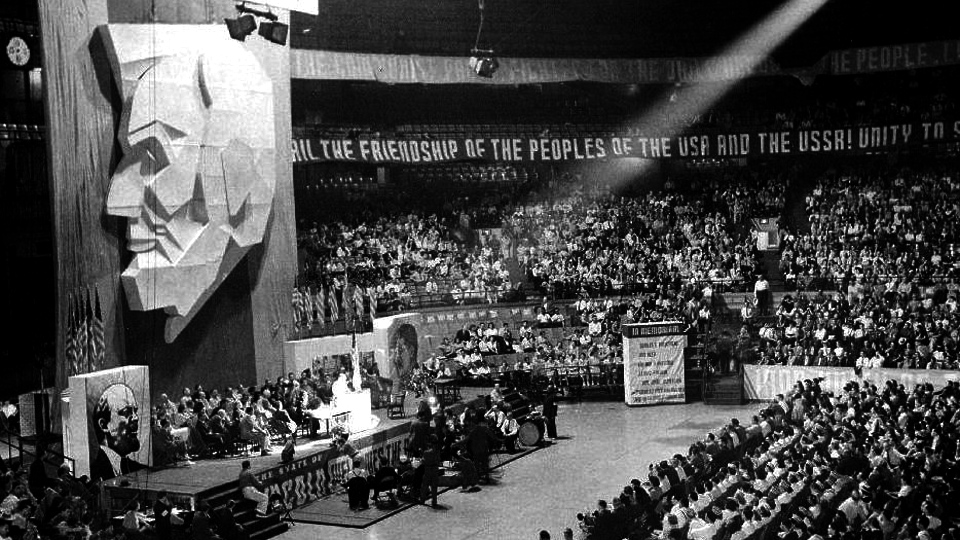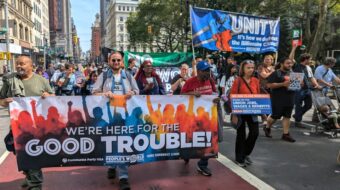
Dark clouds have gathered over the nation. The seemingly unthinkable has occurred. Donald Trump is the next president. The Republican Party controls all three branches of government and a reactionary Supreme Court seems a certainty for the coming years. There are lists of all the recent gains now put at risk and the dangers that lie ahead. You’ve seen them. They’re certainly reason enough for some weeping and gnashing of teeth.
But then of course it’s time to start strategizing how we come back from this defeat. The road ahead will be one of resistance, and the anti-Trump demonstrations in cities across the U.S. last night show there’s a base for it. But beyond spontaneous protest, how do labor and the progressive movement chart a way forward?
The organized labor movement, which saw many of its members back Trump, has yet to present a full assessment. But among some in left circles, there are already calls circulating for a radical break from the Democratic Party, the formation of yet another new third party, or even withdrawal from electoral politics altogether.
Casting blame
Some are arguing that if the DNC hadn’t sabotaged Bernie, Trump would have been beaten. The rogues’ gallery of villains includes Hillary Clinton of course, as well as Donna Brazile, Debbie Wasserman-Schultz, John Podesta, and others. As this explanation goes, the Democrats are beyond hope and liberalism is dying.
In this view, it would seem the Democratic Party is some tidy and compartmentalized thing disconnected from all the variety of movements, organizations, coalitions, and millions of voters that took part in the 2016 campaign. It’s not. And if the Bernie movement couldn’t rack up enough numbers (this time) to overcome Clinton in the primaries, then it’s by no means guaranteed it could have done so against Trump in the general election.
There’s no doubt that the leading faction of the Democratic Party carries a lot of the burden for Tuesday’s loss. The leadership of both parties has failed for years to respond to the very real crises of neoliberal capitalism that led too many (white) working class folks to take a chance on Trump.
As Robert Borosage from Campaign for America’s Future wrote yesterday, “This is about the policies that have been supported by both parties – global trade and tax deals of, by, and for the corporations, financialization and Wall Street bailouts, big money politics and crony capitalism, decades of promises not kept.”
Trump was a candidate that represented change for millions of people who so very much need change in their lives. Responding to the slogan “Make America Great Again” with the tepid and vacuous “America’s already great,” as the Clinton campaign did, falls flat among people who have seen their jobs disappear and economic opportunity vanish for their children.
Yes, racism, misogyny, Islamophobia, and anti-immigrant sentiment are all a part of the explanation for what happened in this election. A big part. But they aren’t the only part. Economics is another one and the fact that counties in states like Wisconsin, Iowa, and others which twice voted for Obama swung this time to Trump is proof that there’s a lot more at work here than simple bigotry.
Surrendering the people of such places to Trumpism and the façade of working class populism being peddled by his Republican party is not a formula for winning the future – and I’m not just talking about elections. If we are going to advance America down the road toward more equality, justice, and sustainability – toward socialism – then we are going to need a very broad group of people on board. And that includes some Trump voters.
This might mean focusing less on the intrigues of the Democratic Party, but it doesn’t mean walling ourselves off into new micro-formations or manufactured forms of political independence which amount to isolationism and sectarianism. Of course the left and labor movement will necessarily have to intervene in the fight for control of the Democratic Party, as Sanders showed us, but that battle has to be a component of a much bigger project, one which this publication has devoted itself to for decades.
The People’s Front
In the 1930s, in the midst of the greatest economic crisis ever and with the threat of world war looming, communists, labor activists, liberals, Democrats, and other progressives gave life to a political strategy which not only blocked the road to fascism in America, but also organized unions in the major industries and won Social Security and unemployment insurance along the way.
That strategy was called “the People’s Front,” or, as its various international historical manifestations have collectively become known, the popular front. At the core of the popular front strategy is the idea of broad-based coalition politics, and it is formulated around a couple of key strategic questions. First, it asks what goal, if won, can change the relationship of forces and open up the possibility for advance. Second, it sets out who are the main opponents and possible allies in the struggle to achieve that goal. This means determining who has the self-interest to fight for the goal and assessing their organization, consciousness, and capacity to join in the fight.
For the popular front of the 1930s, the goal was the containment of fascism and the defeat of the anti-New Deal section of capital and the Republican Party. As delegates to a convention of the Communist Party heard in June 1936, “There are two chief and opposite directions of possible development in political life… All parties and groups must be judged by their relation to these two fundamental political tendencies.”
To win a people’s recovery program in the Great Depression, this meant lining up all the forces of progress on one side to take on the forces of reaction on the other.
A December 1936 document followed up: “Our country, in common with the rest of the capitalist world, is threatened with reaction, fascism, and war… Everything that organizes and activizes the working class and its allies is progress toward socialism; likewise, everything that weakens and discourages the forces of reaction goes in the same direction.”
There were two main camps, and those who cared about stopping the worst assaults of the reactionary right and opening a way forward had to pick sides.
Advance or regress
In the period that has now opened, with the whole apparatus of the federal state under the control of Trump and the GOP, the task before us appears in similarly stark terms.
To build resistance to the Trump agenda and lay the groundwork for a rebound, there is a need to consolidate the widest possible unity – not discounting any possible ally. We already have the basic outlines of this in place.
This all-people’s front includes (or should include) organized labor, movements like Black Lives Matter and Native American organizations, Latinos and immigrant groups, women’s and LGBTQ groups, Asian and Jewish organizations, young people, Muslims and refugees, and so many more. Within its ranks are leftists, liberals, centrists, middle strata, and sections of business. It includes, as well, Democrats truly excited by the historic possibilities the Hillary Clinton candidacy offered.
The immediate task is to battle despair and prevent any slumps of activity among these movements and groups. It’s a loose coalition, not a unitary organization, so there is a tough job ahead.
As mentioned earlier, the popular front of today also has to include – eventually – significant sections of those people who just voted for Donald Trump. Demographic fortune-telling aside, there is no path to sustainable long-term progress that does not peel away Trump supporters (especially white working people) from the GOP and the camp of reaction.
That means the left and the labor movement have to push a populist program of their own onto the agenda. We have to be able to talk convincingly about a new trade regime, about how to create jobs, and invest in the future. The Sanders campaign provided us with an excellent starting point. Let’s build upon it. We came so far in this election and forced the Democratic National Convention to adopt its most progressive platform ever. A majority of Americans voted for that option. That reality can’t be allowed to get lost in all the post-election autopsies.
Like any strategy, the popular front has had shortcomings and misapplications over the years. On its own, it doesn’t provide a ready-made answer for every tactical choice that faces the movements for progress. Of course there have been and will be setbacks. History never moves in such a straight line as the shorthand options of “forward” and “backward” might suggest.
But when the alternatives are a do-your-own thing leftism that spent more time plotting opposition to Clinton than to Trump before Election Day, or isolating and fruitless third party efforts with little connection to labor and the main social movements, the idea of a popular front still stands up pretty well after eighty years. It remains the only viable path for social progress in our diverse country.










